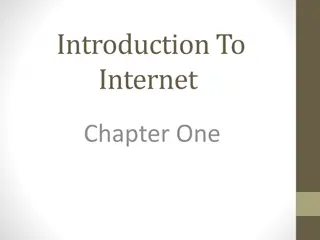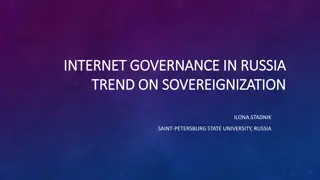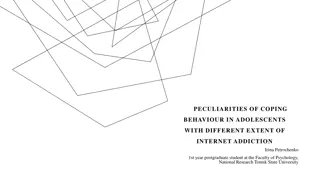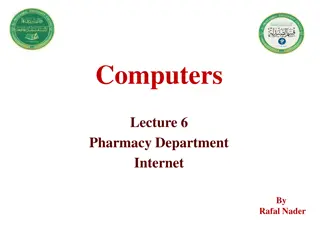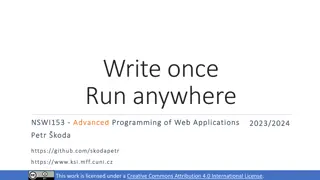Understanding Web Technologies and Internet Standards
Web technologies encompass various tools and techniques used for communication between devices over the internet. It includes web browsers, programming languages, databases, protocols, multimedia elements, and data formats. The World Wide Web (WWW) plays a pivotal role in connecting networks globally, facilitating diverse applications such as sending emails, file transfers, web surfing, and participating in online discussions. Internet standards ensure efficient data communication through established protocols and rules.
Download Presentation

Please find below an Image/Link to download the presentation.
The content on the website is provided AS IS for your information and personal use only. It may not be sold, licensed, or shared on other websites without obtaining consent from the author. Download presentation by click this link. If you encounter any issues during the download, it is possible that the publisher has removed the file from their server.
E N D
Presentation Transcript
What are Web Technologies? Web technologies are the various tools and techniques that are utilised in the process of communication between different types of devices over the internet. Let s break it down into two pieces: web and technology . The web, in this case, refers to the World Wide Web, more commonly known as WWW. It first came into being in 1989 when famous scientist and engineer, Tim Berners-Lee, came up with an efficient mechanism to share resources between scientists all over the world.
What Are The Different Types Of Web Technologies? The basics, which will cover web browsers and some web app development fundamentals Programming languages and frameworks which are used in the development of websites Databases that are used at the backend to store data required or collected by websites Some protocols, that is, rules for communicating on the web Graphic, audiovisual, and other multimedia elements Some data formats that are usually used to transmit data over the internet Other miscellaneous web technologies
UNIT-I INTRODUCTION TO WWW INTERNET STANDARDS ABOUT INTERNET A network is a group of connected, communicating devices such a s computers and printers. An internet i s two or more networks that can communicate with each other( composed of hundreds of thousands of interconnected networks). It is the largest network in the world that connects hundreds of thousands of individual networks a l l over the world. Private individuals a s well a s various organizations such a s government agencies, schools, research facilities, corporations, and libraries in more than 100 countries use the Internet.
History of Internet Early Networking Advanced Research Projects Agency Created ARPAnet Grandparent of Internet Used packet switching to rout data TCP/IP reliability and Protocols identification to ensure Internet
Uses of the Internet Send e-mail messages. Send (upload) or receive (down load) files between computers. Participate in discussion newsgroups. Surfing the web. groups, such a s mailing l i s t s and
Protocols and Standards Communication in computer networks ~ occurs between entities in different systems Entity ~ is anything capable of sending or receiving information Protocol ~ is a set of rules that govern data communication
Principle Elements Syntax ~ refers to the structure or format of the data, meaning the order in which they are presented. Semantics ~ refers to the meaning of each section of bits. Timing ~ refers to two characteristics (when data should be sent and how f a s t it can be sent)
Standards Standards ~ are essential in creating and maintaining an open and competitive market for equipment manufactures and in guaranteeing national and international interoperability of data and communications technology and processes. ~ Standards are developed through the cooperation of standards creation committees, forums, and government regulatory agencies.
Standards Organizations Standard Creation Committees ISO (The International Standard Organization) ~ created in 1947 ~ voluntary organization ~ is an organization dedicated to worldwide agreement on international standards in a variety of fields (scientific, technological, economic activity)
ITU-T(International Telecommunications Union - Telecommunications Standards Sector) ~ is an international standards organization related to the United Nations that develops standards for telecommunications. Two popular standards developed by ITU-T are the V series (data transmission over phone lines) and the X series (transmission over public digital networks)
ANSI (American National Standard Institute) ~ is a nonprofit organization and is the U.S. voting representative to be both the ISO and the ITU-T IEEE (Institute of Electrical and Electronic Engineers) ~ i s the largest national professional group involved in developing standards for computing, communication, electrical engineering, and electronics) EIA (Electronic Industries Association) ~ is an association of electronics manufactures in the United States. (EIA-232-D, EIA-530 standards)
Forums ~ consist of representatives from corporation that test, evaluate and standardize new technologies. Frame Relay Forum ATM Forum and ATM consortium Regulatory agencies FCC (Federal Communications Commission) KCC (Korea Communications Commission) & MSIP (Ministry of Science, ICT and Future Planning)
Internet Standards Internet standard is a thoroughly tested specification that is useful to and adhered by those who work with the Internet It is a formalized regulation that must be followed. There is a strict procedure by which a specification attains Internet standard status. A specification begins a s an Internet draft Working document with no official status and six-month life-time RFC (Request for Comment) Recommendation from Internet authorities
Proposed Standard Is a specification that is stable, well understood, and of sufficient interest to the Internet community. Draft Standard to draft successful independent and interoperable implementations Proposed is elevated standard status after a t l e a s t two With modification, normally becomes an Internet standard Internet Standard standard reaches demonstrations of successful Implementation A draft Internet standard status after
Historic RFCs Superseded by later specifications or never passed the necessary maturity levels to become an Internet standard Experimental RFCs Not implemented in any functional Internet service Informational RFCs Containing general, historical, or tutorial information related to the Internet
Required protocols (RFCs) Must be implemented by a l l Internet systems to achieve minimum conformance For example, IP and ICMP Recommended protocols Not required for minimum conformance; it is recommended because of its usefulness For example, FTP and Telnet Elective protocols Not required and not recommended; but a system can use it to its own benefit.
Limited Use protocols Used only in limited situations; most of the experimental RFCs f a l l under this category Not Recommended Inappropriate for general use; normally a historic (obsolete) RFC may f a l l under this category
Introduction to WWW WWW , "Web" or "W3" The World Wide Web is a way of exchanging information between computers on the Internet. It is the network of pages of images, texts and sounds on the Internet which can be viewed using browser software . It is a way of accessing the information over the medium of the internet. The World Wide Web, or Web, consists of a worldwide collection of electronic documents (Web pages) A Web site is a collection of associated items. Simple and easy to use related Web pages and
A Web server is a computer that delivers requested Web pages to your computer Web 2.0 refers to Web sites that provide a means for users to interact 1989 1990 Tim Berners Lee invents the World Wide Web (www) at Cern . Published in 1992 - Means for transferring text and graphics simultaneously The World Wide Web allows computer users to locate and view documents (i.e., documents graphics, animations, audios or any subject. multimedia-based with videos) on almost text,
Structural Components Clients/browsers to dominant implementations Servers run on sophisticated hardware Caches many interesting implementations Internet the global infrastructure which facilitates data transfer
Semantic Components Hyper Text Transfer Protocol (HTTP) Hyper Text Markup Language (HTML) Extensible Markup Language (XML) Uniform Resource Identifiers (URIs)
Hypertext & Hypermedia Hypertext - Text which contains links to other texts. The term was coined by Ted Nelson around 1965 . Hypermedia - Term used for hypertext which is not constrained to be text: it can include graphics, video and sound
Web browser It displays a web document and enables users to access web documents. Web Server A program that waits patiently for the browser to request a web page. The servers looks for the requested information, retrieves it and send it to the browser or sends an error message if the file is not found. Uniform Resource Locator (URL) - These are the web addresses. The resource locator is an addressing system .
Two basic steps required in making a web page. Create an HTML File Upload file to server Web pages are generally sets of text files coded with special notation called Hypertext Markup Language (HTML) that is interpreted by a web browser program reading the file.
Internet & WWW The internet came first. Internet and WWW are two different concepts. Internet- It is a global computer network made up of thousand of computers & computer network. WWW- It is a system that interlinked via Internet.
Difference between Internet and WWW 1) Internet- is a global system of interconnected computer network. This computers communicate with each other using a common protocol (TCP/IP i.e. Transmission Control Protocol / Internet protocol ) World Wide Web (WWW) : It is one of the services that run on internet. WWW is a system of interlinked hypertext documents accessed via Internet. Way of accessing the information .
2) The Internet and the Web are two separate but related things. It is a massive network of networks. It millions of computers together connects forming a network in which any computer can communicate with any other computer as long as they are both connected to the Internet. WWW- The World Wide Web, or simply Web, is a way of accessing information over the medium of the Internet. So the Web is just a portion of the Internet. Internet globally,
Web Browsers Eg: Internet Explorer Firefox Opera Safari Google Chrome
A home page is the first page that a Web site displays Web pages provide links to other related Web pages Downloading is the process of receiving information Search engine Finds information related to a specific topic Classifies Web pages in an organized set of categories- Images, Videos, Audio, News, Maps, Blogs, People or Businesses.
Web publishing - It is the development and maintenance of Web pages WWW is a way of exchanging information. WWW is constructed using HTML. WWW is one of the services that run on internet.



